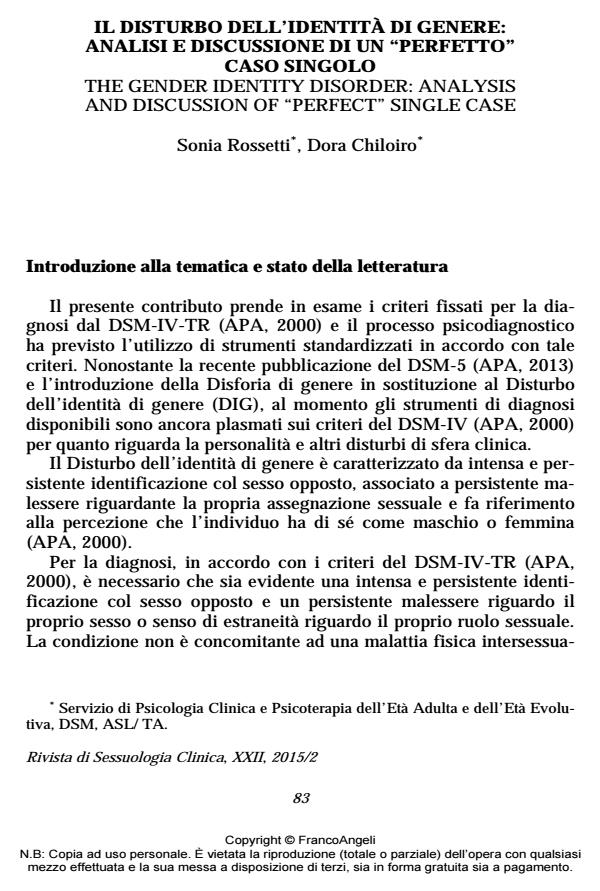Il disturbo dell’identità di genere: analisi e discussione di un "perfetto" caso singolo
Titolo Rivista RIVISTA DI SESSUOLOGIA CLINICA
Autori/Curatori Sonia Rossetti, Dora Chiloiro
Anno di pubblicazione 2015 Fascicolo 2015/2
Lingua Italiano Numero pagine 14 P. 83-96 Dimensione file 86 KB
DOI 10.3280/RSC2015-002004
Il DOI è il codice a barre della proprietà intellettuale: per saperne di più
clicca qui
Qui sotto puoi vedere in anteprima la prima pagina di questo articolo.
Se questo articolo ti interessa, lo puoi acquistare (e scaricare in formato pdf) seguendo le facili indicazioni per acquistare il download credit. Acquista Download Credits per scaricare questo Articolo in formato PDF

FrancoAngeli è membro della Publishers International Linking Association, Inc (PILA)associazione indipendente e non profit per facilitare (attraverso i servizi tecnologici implementati da CrossRef.org) l’accesso degli studiosi ai contenuti digitali nelle pubblicazioni professionali e scientifiche
Il disturbo dell’identità di genere è una condizione clinica caratterizzata da una mancata integrazione tra il sesso biologico determinato geneticamente e la rappresentazione della propria identità sessuale. In tale condizione la persona non si riconosce nel proprio ruolo sessuale esperendo una serie di vissuti emotivi contrastanti e caratterizzati dal desiderio di cambiare le proprie sembianze. Obiettivo del presente lavoro è fornire un panorama generale circa il disturbo e sulle procedure legali per la ricostruzione chirurgica del sesso. Gli Autori discuteranno il caso clinico di un paziente valutato presso la S.C. di Psicologia Clinica e Psicoterapia dell’Età Adulta e dell’Età Evolutiva della ASL di Taranto. L’attenzione sarà posta sull’ indagine psicodiagnostica utilizzata per giungere alla diagnosi. Lo scopo è ritrarre le perfette condizioni psicologiche che una persona con tale condizione clinica dovrebbe possedere per ricevere l’autorizzazione alla ricostruzione chirurgica del sesso.
Parole chiave:Disturbo dell’identità di genere, transgender, transessualità, esame psicodiagnostico, diagnosi, ri-assegnazione chirurgica del sesso
Sonia Rossetti, Dora Chiloiro, Il disturbo dell’identità di genere: analisi e discussione di un "perfetto" caso singolo in "RIVISTA DI SESSUOLOGIA CLINICA" 2/2015, pp 83-96, DOI: 10.3280/RSC2015-002004